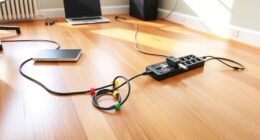All you wanted to know about subwoofers
Subwoofers are necessary for creating the bass end. Here is the bottom line. As I started learning about audio, home subwoofers were very special devices that were of interest only to those with huge pipes and music lovers! Things have changed very much since this ‘distance’ period and nowadays sub-woofers have a much higher acceptance rate than sonic advantages and can easily become a standard part of modern audio and video monitoring systems.
What is a subwoofer?
All sound has frequencies. High-pitched sounds have greater frequencies. Normal speakers and surround sound devices are not effective at reproducing low-frequency sound. So music can sound flat. The subwoofer produces the lower frequency within a musical genre called bass/sub-bass, which is amplified in the woofer. Usually, the subwoofer is enough to give listeners an accurate sense of the music and the bass. The frequencies range of 20 – 200 Hz highlight instruments that fall within this range such as guitar, bass organ, and kick drum.
Subwoofers are normally active devices, i.e. they need an amplifier to drive them. With active subwoofers, you can adjust the input level of the signal driving your sub-woofer, which comes in handy when you have small speakers that don’t produce much bass or when you want to experiment with different crossover frequencies. Just make sure the subwoofer can handle the input signal, either by having a built-in crossover or via the speaker level input.
The frequency response characteristics of subwoofers are similar to those of your main speakers. It means that if your subwoofer has -3dB point at 50 Hz it may have a good enough frequency response for various musical styles.

Since there are two main types of subwoofers, they can be further divided into two groups: ported and sealed enclosures. Sealed enclosures are more accurate in their reproduction but you will need a bigger enclosure in order to obtain a decent amount of low-end bass extension. Ported enclosures are smaller and cheaper but they use an additional ‘ported’ chamber, which is normally used to enhance the bass response. This comes with the disadvantage of slightly less accurate sound reproduction.
It is not necessary to match subwoofers and main speakers in terms of their power handling capabilities. If you have small speakers you can happily plug your subwoofer into the 120-watt power amp and it will work just fine. On the other hand, if you have large speakers that are rated for 400 watts of continuous power you may need a subwoofer capable of handling up to 600 or 800 watts. If your speakers can handle more than their recommended power, don’t worry about this because most modern amplifiers won’t clip even when you drive them to their maximum power.
Most modern home theater systems have a powered subwoofer with a built-in crossover, which makes it easy to set up and use. If you have a receiver that has a dedicated LFE channel, be sure the frequency response of your speakers matches that of the subwoofer. If you are running the main speakers full range (no low-frequency cutoff) make sure their frequency response is flat enough to cover the entire spectrum, because by setting your speaker’s low-frequency cutoff too high it will cut off some of the subwoofer’s bass, thus reducing your system’s maximum output capability.
The first thing to do when setting up the subwoofer is to adjust it so you get the highest possible amount of bass extension. Start with setting the low-frequency cutoff control (the crossover) to its maximum value; don’t worry about distortion because your system may not be able to produce very low bass frequencies at all. Then play some powerful music, like heavy metal, rock, or techno, that has a lot of low basses. Slowly turn up the volume until you start to hear the subwoofer’s cone flapping back and forth rapidly, indicating it can’t handle any more power. At this point set the cutoff point again by about 3dB until you get rid of distortion but don’t lose too much of the frequency response.
Advantages of The Subwoofer
Proper construction makes subwoofers extremely efficient and comfortable. It’s also easy to spoil any opportunity if the subwoofer doesn’t suit the purpose and it is important to note the fact that there were 9 unsatisfactory setups. Improper installation of subwoofers can lead to excessive bass and poor definition. It can sometimes appear that satellites are larger than sub-woofers as the spectrum varies significantly. It’s an intersection-oriented integration that creates or destroys the system.
Where Should I Place my Subwoofer?
Be careful not to place your subwoofer too close to the walls or corners since this will result in an excess of bass extension. The best spot would be inside a corner, where it can produce room-shaking bass without the risk of over-excursioning. Keep in mind that even though you set your speaker’s low-frequency cut off at 60 or 80 Hz it may still be producing some bass below that frequency because of the room’s natural resonance. If your home theater is in a dedicated room with heavy soundproof walls and high-density acoustic foam on the ceiling you may not need a subwoofer at all, unless you want to increase your system’s output capability.
Matching Subwoofers to Main Speakers
If you can adjust the low-frequency cutoff of your speakers and subwoofer (which is the case with most home theater systems) start by setting both controls at about 80 or 100 Hz. Then play some music and slowly turn up the frequency until you hear a significant drop in the music’s level. This frequency is normally where your lowest main speaker starts to roll off, so you don’t want any more low-frequency energy from the subwoofer. In other words, you will hear a certain amount of bass coming from your speakers and the same amount from the subwoofer, with both combined producing a flat frequency response.
If your speaker’s crossover control is not adjustable and they can’t produce enough bass, you may need a bigger subwoofer than the ones included in your system. Another option would be to buy an external 3-channel power amplifier which has been specifically designed for home theater use and hook it up to your main speakers + center channel.

Subwoofer Placement and Room Resonance
The industry lacks a clear solution to the issue of subwoofer placement. Asking for advice on forums or speaking with your local dealer can help you find out what other users have experienced with their particular setups, but keep in mind that there were 9 unsatisfactory setups based on the author’s research. If you experience this, you should definitely move the subwoofer somewhere else in the room to see if there’s a better spot available.
Even though placing your subwoofer inside the front wall is the best way to enjoy ultra-low bass frequencies it may not be practical for everyone because of possible problems with room resonance resulting in excessive bass. This problem can be solved by placing the subwoofer inside a corner, like in most home theater setups, or putting acoustic panels on the wall to reduce room resonance.
Keep in mind, your location also matters: Even the best subwoofer in the world might not perform well in an acoustically poor room.
Reasons for placement of subwoofers in the front wall:
- Better bass extension and detail
- Omproved localization and soundstaging (front stage)
- More impact and punch; visceral bass, better effects during movies or video games
Reasons for placement of subwoofers in the corner:
- Easy to set up (no need for stands)
- Reduced room reflections (there’s no wall behind it)
- No risk of overdriving the speaker or amp
- No risk of excursioning the speaker
If you play too low, you’ll probably hear a lot of bass from your main speakers and feel the floor shaking. A professional installer will know exactly where to set the crossover frequency on your receiver or amplifier to avoid this problem, but they may charge up to $300 for the service. If you can tune your system, adjust it until you hear a drop in the volume of the music – that’s where the subwoofer starts playing its own sound.

From here, you can experiment with placing your subwoofer on stands inside or outside of corners, next to walls, or on open spaces. Choosing between these options will depend on the amount of bass you want, whether or not you prefer increased localization and sound staging (in front of the stage), or more impact/punch during action movies. Generally speaking, corner placement increases localization but reduces articulation while placing your subwoofer next to a wall gives you tremendous articulation but reduces localization & soundstage. You may also consider putting your subwoofer on an open space for even less articulation and localization, but more impact & punch.
How do Subwoofers Work?
A subwoofer is not very complicated. The main components are the woofer driver, an amplifier, and a passive crossover network that sends bass frequencies to the sub.

The sound you hear from your speakers comes from the drivers inside the enclosure – tweeters for highs, midrange/midbass drivers for mids & vocals, and woofers for lows. If your speakers are capable of producing enough bass all by themselves, you can hook them directly to the amplifier output to filter out highs and mids. The subwoofer works differently because it needs to reproduce lower frequencies than what most drivers are designed for. Instead of trying to cross over at 80Hz or 100Hz as many people do, a subwoofer’s cutoff frequency should be at least 40Hz. Low-pass filtering (low pass filter) is a signal that means removing the upper frequencies from it.
Subwoofer and Satellite System
A passive crossover network is made of capacitors, coils, and resistors that split your audio signal into bass, mids & highs before feeding them to different drivers inside the speaker enclosure. In most cases, you’ll find two sets of binding posts on your subwoofer. One is for connecting the main amplifier, and the other lets you hook up a separate amplifier to power your satellite speakers with bass frequencies.
A subwoofer is an omnidirectional speaker, meaning it disperses sound equally in all directions like any full-range driver (tweeter, midrange, woofer). The only difference is that a subwoofer uses a larger cone and longer throw to produce lower frequencies than regular speakers. This means they need more power than most people’s amps can deliver. If you’re looking for just one extra speaker, we recommend the Klipsch R-12SW Subwoofer.
Looking for an immersive audio experience? Look no further than the Klipsch R-12SW subwoofer. This powerful device features phase control, low pass crossover, and an all-digital amplifier delivering 400 watts of pure bass power. It’s compatible with most receivers, making it the perfect addition to any home theater setup.
- Powerful 12″ copper-spun front-firing woofer
- All-digital amplifier delivers 400 watts of dynamic power
- Equally impressive with music and movies; Brushed black polymer veneer cabinet with satin painted plinth
- Low pass crossover and phase control
- Line/LFE inputs for compatibility with most receivers
The main reason for using subwoofers is to reproduce bass frequencies that your main speakers can’t produce. This way you’ll get deeper, tighter, and cleaner bass for better movie & game immersion – without waking up the neighbors or shaking everything in your house apart.
f you’re not familiar with the aforementioned ones, be aware that they’re powerful enough that ripples can travel through your body like waves or vibrations down your spine. The subwoofer uses speaker drives or the “woofer,” (like dogs) of varying sizes. Variables such as the base size or target frequencies determine the size of a subwoofer’s total size. Subwoofers achieve the speakers’ sound by having a system that can increase and decrease the output, which ensures that the cones on subwoofers and speakers are moving at the same speed.
Types of Subwoofers
Subwoofers may be used in passive mode. A passive subwoofer is a subwoofer with a connection with an external amplifier that reproduces bass. Subwoofers require enormous energy to generate massive amounts of air that reproduce lower frequencies. In other words, a passive subwoofer connection with the receiver might not be perfect for producing a good bass quality. The subwoofer can sound disorientated if the subwoofer lacks power. Therefore, for passive subwoofers to sound best, they have to use an internal amplifier capable of producing the energy required. A subwoofer has an amplifier and crossover.
Bass Management in Subwoofers
It is impossible to get an audio home entertainment experience using subwoofers unless their frequencies are distributed properly. Bass managers come into the picture here. Bass management of subwoofers involves the maintenance of subwoofers and the main speaker with appropriate frequency distribution. Bass managers, for example, guarantee that only lower frequencies are delivered to reproduce clear bass. The bass control procedure is either done manually or automatically. Receivers with manual crossovers can be configured manually, while receivers with manual implementations can be configured.
Drivers of A Subwoofer – Give it Low Frequencies
The speaker of a subwoofer is the smallest and most powerful unit of a subwoofer. The density of a cone determines its ability to reproduce low frequencies. Although some manufacturers indicate the size of the driver, it is more accurate to look at its total power. When you buy speakers, check their power rating. A subwoofer with a power rating of 100 watts means that the subwoofer can produce constant bass, which is more or less 75-100 watts.
Rear channel speakers are known as “surround” speakers because they provide information on the back of the room to create an effect of being immersed in space. Most Dolby surround sound systems require these speakers to present the dialogue information (the center channel) and to play music or special effects. The subwoofer can also be used without any extra speakers, however, the subwoofer has its own benefit of giving you a better bass experience than just your regular satellite speakers.
Subwoofer, Cables, Connection, HDMI, Sound Systems
A home theater system can be described as a combination of a few different speakers, a receiver, and a Blu-ray player or DVD player. The process of connecting all the devices can be confusing, but it’s easier with our step-by-step guide.
In the last few years, HDMI has become more common on home theater systems because it delivers high-quality sound and images. The best DVD and Blu-ray players use HDMI to connect to the TV, and many Satellite or cable boxes also have an HDMI output that can be connected to your TV.

Many home theater receivers have multiple HDMI outputs that allow you to send the same sound and picture information (multi-channel audio such as Dolby TrueHD or DTS-HD Master Audio) to the TV and also have a “second zone” of audio or video that can be fed to another room from the same receiver.
Optical digital connections are becoming more common because they allow for sound and picture information to be sent over a single cable (they also transmit Dolby Digital and DTS). You can use an optical connection between your Blu-ray player or satellite/cable box and home theater receiver. The only catch is that the TV must have an Optical Digital Audio Out jack in order to hear sound from the TV through your home theater system speakers.
For many years, cable boxes include a terminal called “Monitor”, which sends video information to the TV. HDMI is a higher quality replacement for the “Monitor.” If your cable box does not have an HDMI output, you can use the Monitor terminals from your cable box to connect it to your home theater receiver.
The satellite TV system provides audio and picture signals that go directly into the back of a television set or video monitor. Satellite receivers usually have an HDMI output that you can use to send the same information (satellite TV system, such as DTV) to your home theater receiver and TV.
Note: The satellite dish usually requires a separate installation where it points out of the window.
Component video connections are not used by most manufacturers because they provide lower quality than HDMI or composite video connections. Some high-quality receivers with progressive scan will have component video inputs and outputs. You can also connect a special DVD player or Blu-ray disc with component video out to your home theater receiver.
You will probably need to use four colors of audio cables (red, white, yellow and black) in addition to the yellow cable that is used for video.
If you do not have color-labeled connectors on the back of your system, write down or remember this information: Video is almost always blue; audio left (mono) is usually red; audio right (stereo) is white/black; subwoofer channel has no label.
How to get Subwoofer Alignment Right?
In the right place, the subwoofer should be properly positioned to match a subwoofer to the speaker. Here is a practical place to place the subwoofer and speakers. Practical placement between Subwoofers & Primary Speakers means the proper placement of the subwoofer and the primary speaker. A few sub-models have phase adjustment capability in the cab. During the synchronizing phase between a speaker and sub speaker, a new feature has been implemented which helps to choose the correct speaker. Installing subwoofers in homes starts with positioning them in the appropriate listening position.
Can Subwoofers blow?
Subwoofers usually fail because of overpowering, underpowering, or shorting. Subwoofers can be powered over the limits of their ability, so the coil can burn. Overpowering subwoofers can happen with high power amplifier settings that raise the gain and volume for long periods of time. Also, never increase the volume above the maximum volume of the sub. Subwoofers can explode when clipped too. Clipping happens when the subwoofer receives current with no coil movement. The coil cannot change its temperature. This coil gets hot over time, burning out.
Tuning Your Subwoofer (bass Response)
This means you must make your subwoofer sound good for the highest bass quality without damaging them. It is recommended you use correct gain and crossover filter settings if your subwoofer sounds right without exceeding a setpoint. Improper tuning in the subwoofer may result in bad bass response and even blowing the subwoofer. When tuning subwoofers, use earphones to determine when it’s best to listen to or adjust its sound for additional reasons when something seems not quite as good. Tuning of the Subsonic Subwoofer can take place at the right listening location. Once you find the best listening place, it is possible to adjust your subwoofer.
What should I look for in a subwoofer?
So what should I look for in a subwoofer? Subwoofers can be quite large and take up a lot of space. If you’re looking for the best way to get deep bass, make sure to measure your room before buying your subwoofer. You will want the largest one that serves your space perfectly.
Some people like to buy subwoofers that are designed for home theaters rather than satellite speakers, but it can be just as easy to convert.
A single subwoofer produces deeper bass than two satellite speakers and better power than point-source speakers. Some people do not like how one subwoofer takes up so much space, while others do not want to buy two separate speakers. The best option is to build a subwoofer for satellite speakers.
There are many different brands of speakers available on the market, and there is no better place to go than eBay if you want them at a great price. You can do everything from buying replacement parts for your existing speakers to building your own subwoofer, allowing you to get exactly what you need without spending too much.
Satellite and Subwoofer Combination
Everyone wants the best sound possible when they are enjoying their favorite TV programs, playing video games or listening to music. But not everyone has the money for an expensive sound system in their living room (or listening room ), so making your own is a good way to get clear sound without having to empty your bank account.
Building your own subwoofer can help you get that extra bass that you have always loved, giving you a more rounded sound that can be adjusted to your liking.
As you’ll see, it is much easier to connect the satellite speaker and subwoofer in practice.
How many watts is a good subwoofer?
There’s no one direct answer to this. Most people assume the more power = louder and better, but that’s not always true with subwoofers. It takes a lot of watts to move a speaker cover a large area so if you have a larger room you’ll need a larger subwoofer. If your goal is getting as much SPL as possible you should look into getting a larger subwoofer or two small ones.
Typically, the biggest living rooms will have the most power requirements for subwoofers. For example, if you are planning on putting your speakers in a large room with ceilings at least 10 feet tall, it may be wise to invest in more powerful subwoofers.

What makes a subwoofer good?
A good woofer requires a linear driver (which is expensive), precise and powerful amplifiers (which are expensive and well designed and manufactured cabinets that are… expensive).
What is a good subwoofer frequency range?
The typical frequency range for a subwoofer is 20–200Hz for consumer electronics, above 100Hz for live audio and below 80Hz for THX-certified systems. Subwoofers can only be used to increase frequencies on loudspeakers that cover higher frequencies.
Subwoofer Sound Waves
Subwoofers produce sound waves that are designed to give you the deepest bass possible for your living room. You can use earphones to determine when it’s best to listen to or adjust its sound. You will want the largest one that serves your space perfectly. Some people like to buy subwoofers that are designed for home theaters, while others do not want to buy two separate speakers. The best option is to build a subwoofer for satellite speakers.











